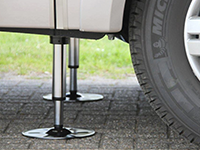
Hydraulic Levelling, is it for me?
When you reach your holiday destination with your Roller Team motorhome, the initial task is to level it. Whether it's a brief stopover or a two-week summer retreat, a level vehicle is imperative for numerous reasons. The traditional manual approach to levelling is laborious, time-consuming, and especially challenging when setting up in low-light conditions or after an extended journey. Fortunately, a hydraulic levelling system eliminates all these hassles, effortlessly achieving perfect levelling in under two minutes. This allows you to focus on unpacking your bags and immersing yourself in your vacation. In essence, all it takes is the press of a button, and the system handles the levelling for you.
Here are some essential facets to keep in mind when contemplating a hydraulic levelling system. While more comprehensive details about the systems can be found below, these some key points offer a concise overview:
Pros:
These systems offer precise levelling, ensuring that your motorhome is perfectly level, which is essential for comfort, preventing appliances from malfunctioning, and extending the life of your motorhome.
Hydraulic levelling systems provide excellent stability, reducing the rocking and swaying that can occur when your motorhome is not level.
They are user-friendly and often come with a user interface that provides real-time feedback on the levelling process.
Many systems allow you to store for long periods with the weight off the wheels which will avoid long term damage to the tyres
They hydraulic system could be used to lift the vehicle to allow for a degree of maintenance or changing of wheels (always use axle stands when working under your vehicle)
Cons:
Hydraulic systems require regular maintenance to ensure they function properly. This includes checking for leaks, inspecting hydraulic fluid levels, and lubricating moving parts.
These systems add weight to your motorhome, which can impact fuel efficiency and the overall weight capacity of your motorhome. You need to ensure that your motorhome can accommodate the added weight.
Hydraulic levelling systems are more complex than manual levelling methods, which means there's a higher chance of something going wrong. If a hydraulic component fails, it can be challenging to fix, and repairs can be costly.
Hydraulic levelling systems rely on the motorhome electrical system or a separate power source, which means you may need to connect to shore power or run a generator to use them. This can be a limitation if you're camping in remote areas without access to electricity.
In summary, hydraulic levelling systems offer convenience and precision when levelling your motorhome but come with a higher initial cost, maintenance requirements, and some limitations related to weight and power. Whether they are suitable for your needs depends on your budget, camping style, and willingness to invest in the added comfort and convenience they provide.
How does it all work?
Hydraulic levelling systems are commonly used in various applications, including vehicles like motorhomes to stabilize and level them on uneven terrain. These systems utilize hydraulic principles to extend and retract levelling jacks or stabilizers, ensuring that the vehicle is stable and level.
Hydraulic Fluid Reservoir:
The system typically begins with a reservoir that contains hydraulic fluid, usually hydraulic oil. This reservoir stores the fluid that will be used to power the levelling jacks.
Hydraulic Pump:
A hydraulic pump is responsible for pressurizing the hydraulic fluid. It can be driven by an electric motor or a vehicle's engine. When activated, the pump draws fluid from the reservoir and pressurizes it.
Hydraulic Lines:
Pressurized hydraulic fluid is then transferred through a network of hydraulic lines or hoses to the levelling jacks or stabilizers at various locations on the vehicle.
Levelling Jacks or Stabilizers:
The hydraulic fluid is delivered to the levelling jacks or stabilizers. These are typically located at the corners of the vehicle or at strategic points for proper support. Each jack can be extended or retracted independently.
Extend or Retract:
To level the vehicle, the hydraulic system activates specific jacks to extend or retract as needed. If one side of the vehicle is lower than the other, the system will extend the appropriate jacks to lift that side until it's level. Conversely, if a side is too high, the system will retract the jacks to lower it.
Levelling Sensors:
Many hydraulic levelling systems are equipped with levelling sensors or auto-levelling systems that can automatically detect the vehicle's orientation and adjust the jacks accordingly. This automation simplifies the levelling process for the user.
Manual Control:
In addition to automatic levelling, most hydraulic levelling systems also offer manual controls, allowing users to adjust the jacks individually or manually if needed.
Stability:
Once the levelling jacks are extended to the correct positions, the hydraulic system maintains pressure in the jacks to keep the vehicle stable and level. The pressure is regulated to ensure that the vehicle doesn't exert excessive force on the jacks.
Monitoring:
Users can typically monitor the levelling process and system status through a control panel or display inside the vehicle, which provides information on the current level and status of each jack.
Hydraulic levelling systems offer convenience and ease of use for levelling and stabilizing vehicles on uneven ground. They are commonly found in motorhomes, campers, and trailers to provide a comfortable and stable environment for occupants.

